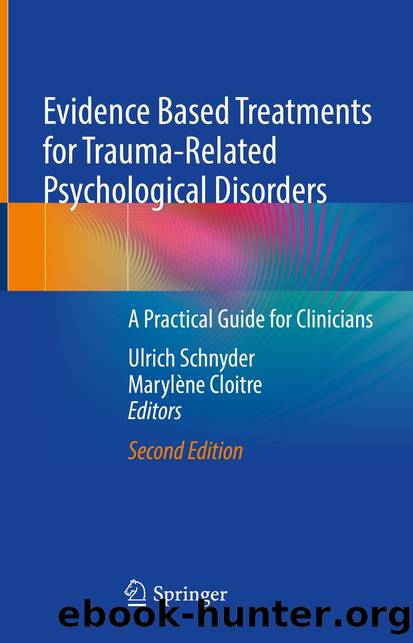Evidence Based Treatments for Trauma-Related Psychological Disorders by Unknown

Author:Unknown
Language: eng
Format: epub
ISBN: 9783030978020
Publisher: Springer International Publishing
13.3 BEPP Protocol
The BEPP protocol consists of 16 weekly sessions of 45 min each. The sessions are structured in the following order (Gersons and Olff 2005):
The overlapping numbers indicate that the separate elements of the therapy may both be the focus in a single session. In practice, the number of sessions needed for the different modules can vary dependent on the complexity of the case and the experience of the therapist.
13.3.1 First Session: Psychoeducation
Psychoeducation is a powerful tool to help patients understand the relationship between the traumatic event(s) and their PTSD symptoms. Symptoms of PTSD are explained as a psychological and physiological state which is functional when danger looms but is dysfunctional and exhausting when there is no threat anymore. For instance, to avoid walking on the grass because one fears mines under the surface, like in Afghanistan, is not functional in most other countries. Most symptoms are beyond control and triggered by conscious and unconscious associations related to past traumatic experiences. One is hyperalert, agitated, and easily startled and has difficulty sleeping and concentrating on the daily routines, because one cannot relax and does not feel safe due to experiencing ongoing danger. By explaining the symptoms of PTSD as resulting from the traumatic experiences, people start to understand that they are not crazy and that the symptoms have had their function in the face of real danger. Avoidance of triggers of the trauma helps to briefly suppress emotions but is counterproductive in the long run. When a traumatized person wants to process the trauma, it is necessary and very helpful to feel, accept, and understand the strong emotions. Being overwhelmed by remembrances of the traumatic event and the feeling as if this is going to happen again creates the feeling of being powerless and being in desperate need of control. Psychoeducation helps to regain part of that feeling of control. The next step in this first, or sometimes second, session is to explain the rationale of the BEPP treatment. The imaginal exposure, the letter writing, and the use of memorabilia are explained as tools to return to the terrible experiences in a vivid way in order to feel and accept the intense emotions and connect them to the trauma. It concerns emotions like sorrow, grief, anger, hate, shame, disgust, and horror. After this phase, which is emotionally heavy, the meaning-making part will start. The patient learns that the world is not as safe as we want it to be and that we are not invulnerable. It will take time and effort to start trusting others again. Finally, the farewell ritual will be explained as the last confrontation with the frightening memories of the trauma and oneâs suffering from the experiences for closure, followed by celebrating the comeback to normal life. In fact, it is a transitional ritual as well, to end the treatment and to go on without the therapist from this point on. Prediction of the difficult processes involved in the various parts of the therapy will motivate the patient for the hard work, especially during imaginal exposure.
Download
This site does not store any files on its server. We only index and link to content provided by other sites. Please contact the content providers to delete copyright contents if any and email us, we'll remove relevant links or contents immediately.
The Art of Thinking Clearly by Rolf Dobelli(8873)
The 5 Love Languages: The Secret to Love That Lasts by Gary Chapman(8536)
Mindhunter: Inside the FBI's Elite Serial Crime Unit by John E. Douglas & Mark Olshaker(7853)
Becoming Supernatural by Dr. Joe Dispenza(7125)
The Road Less Traveled by M. Scott Peck(6651)
Nudge - Improving Decisions about Health, Wealth, and Happiness by Thaler Sunstein(6645)
Enlightenment Now: The Case for Reason, Science, Humanism, and Progress by Steven Pinker(6417)
Win Bigly by Scott Adams(6329)
Mastermind: How to Think Like Sherlock Holmes by Maria Konnikova(6258)
The Way of Zen by Alan W. Watts(5813)
Factfulness: Ten Reasons We're Wrong About the World – and Why Things Are Better Than You Think by Hans Rosling(4033)
The State of Affairs by Esther Perel(3947)
Gerald's Game by Stephen King(3929)
Man's Search for Meaning by Viktor Frankl(3652)
The Confidence Code by Katty Kay(3576)
Thinking in Bets by Annie Duke(3542)
The Worm at the Core by Sheldon Solomon(2929)
Enlightenment Now by Steven Pinker(2926)
Liar's Poker by Michael Lewis(2823)
